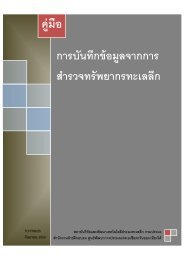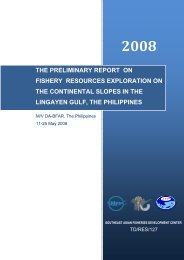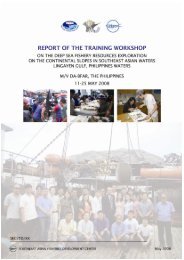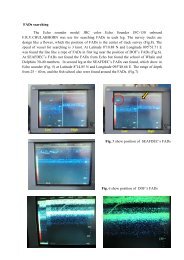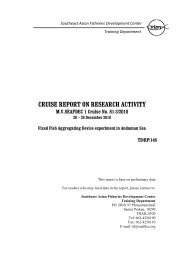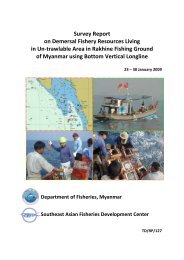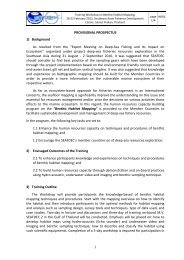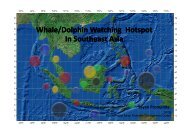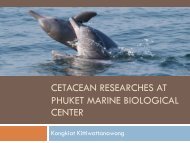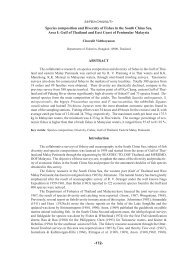Biomass Estimation by Hydro-acoustic Methods in the ... - SEAFDEC
Biomass Estimation by Hydro-acoustic Methods in the ... - SEAFDEC
Biomass Estimation by Hydro-acoustic Methods in the ... - SEAFDEC
You also want an ePaper? Increase the reach of your titles
YUMPU automatically turns print PDFs into web optimized ePapers that Google loves.
S2/FR3<br />
<strong>Biomass</strong> <strong>Estimation</strong> <strong>by</strong> <strong>Hydro</strong>-<strong>acoustic</strong> <strong>Methods</strong> <strong>in</strong> <strong>the</strong> South Ch<strong>in</strong>a Sea,<br />
Area II : Sarawak, Sabah and Brunei Darussalam.<br />
Yuttana Theparoonrat<br />
Tra<strong>in</strong><strong>in</strong>g Department, Sou<strong>the</strong>st Asian Fisheries Development Center.<br />
ABSTRACT<br />
The abundance of fisheries resources and <strong>the</strong>ir structure off shore of Sarawak, Sabah and Brunei<br />
Darussalam were <strong>in</strong>vestigated under <strong>the</strong> <strong>SEAFDEC</strong> Collaborative Research Survey. <strong>Hydro</strong>-<strong>acoustic</strong><br />
survey<strong>in</strong>g <strong>by</strong> us<strong>in</strong>g a scientific echo sounder model FQ-70 was conducted for estimat<strong>in</strong>g <strong>the</strong> fish<br />
abundance and biomass. Two survey cruises were carried out <strong>by</strong> M.V. <strong>SEAFDEC</strong> dur<strong>in</strong>g 10 July to 2<br />
August 1996 and 1 to 24 May 1997 for pre and post-nor<strong>the</strong>ast monsoon seasons, respectively. The<br />
scientific echo-sounder was equipped with an echo-<strong>in</strong>tegrator and two quasi-ideal beam transducers<br />
with operat<strong>in</strong>g frequencies of 50 and 200 kHz. For pre and post-nor<strong>the</strong>ast monsoon season was<br />
1,717,852 tons and 956,397 tons, respectively. The maximum fish abundance were found at <strong>the</strong> water<br />
depth between 100 to 200 m was 92.4% and 49.8% of total abundance for pre and post-nor<strong>the</strong>ast<br />
monsoon season, respectively.<br />
Key words: <strong>Biomass</strong> estimation, Acoustic survey, South Ch<strong>in</strong>a Sea, Sarawak, Sabah, Brunei<br />
Darussalam.<br />
Introduction<br />
Mar<strong>in</strong>e fisheries resources are migrate accord<strong>in</strong>g to <strong>the</strong> change of seasonal and maturity state.<br />
The abundance estimation of such migratory species are need to design <strong>the</strong> survey with cover all that<br />
particular area. Sou<strong>the</strong>ast Asian Fisheries Development Center (<strong>SEAFDEC</strong>) was proposed to conduct<br />
<strong>the</strong> Collaborative Research Survey on <strong>the</strong> mar<strong>in</strong>e fisheries resources and <strong>the</strong> environmental factors <strong>in</strong><br />
<strong>the</strong> South Ch<strong>in</strong>a Sea of <strong>SEAFDEC</strong> member country’s waters. Two survey cruise were performed <strong>by</strong><br />
M.V. <strong>SEAFDEC</strong> dur<strong>in</strong>g pre-nor<strong>the</strong>ast monsoon season from 10 July to 2 August 1996 and postnor<strong>the</strong>ast<br />
monsoon season from 1 to 24 May 1997. The objective of <strong>the</strong> survey is to estimate <strong>the</strong><br />
abundance of fisheries resources and <strong>the</strong>ir structures at <strong>the</strong> off shore of Sarawak, Sabah and Brunei<br />
Darussalam waters, and to study on <strong>the</strong> variation of <strong>the</strong> abundance dur<strong>in</strong>g pre-nor<strong>the</strong>ast monsoon and<br />
post-nor<strong>the</strong>ast monsoon season.<br />
Materials and <strong>Methods</strong><br />
The survey area was divided <strong>in</strong>to 79 oceanographic survey stations (Fig 1). Each station were<br />
located at 30 nautical miles apart. The hydro-<strong>acoustic</strong> survey <strong>by</strong> us<strong>in</strong>g scientific echo-sounder model<br />
FQ- 70 are carried out along <strong>the</strong> parallel cruise track of 30 nautical mile. Scientific echo-sounder was<br />
equipped with dual frequency <strong>by</strong> us<strong>in</strong>g two quasi-ideal beam transducers with operated on 50 kHz<br />
and 200 kHz. This <strong>acoustic</strong> survey system were equipped with echo <strong>in</strong>tegrator, calibration system and<br />
data recorder. The system is designed so that a vast amount of data can be stored onto <strong>the</strong> floppy disk<br />
memory and processed <strong>by</strong> <strong>the</strong> data analyzer. The raw data from Furuno FQ-70 software <strong>in</strong> form of K3<br />
ASCII code are us<strong>in</strong>g for <strong>the</strong> calculation. The volume back scatter<strong>in</strong>g strength (SV) of high frequency<br />
(200 kHz) was calculated from data recorded from 10 to 200 m.<br />
The calibration of FQ-70 is conducted before <strong>the</strong> survey cruise is performed at <strong>the</strong> survey<br />
station number 1. M.V. <strong>SEAFDEC</strong> is anchored at <strong>the</strong> water depth of 36 meter where <strong>the</strong> clam sea and<br />
weak current of 0.4 knot. The calibration is performed <strong>by</strong> us<strong>in</strong>g standard hydrophone model TW-<br />
9103-S attached at 1 meter under <strong>the</strong> transducer sound beam axis. Both low (50 kHz) and high fre-<br />
-362-
S2/FR3<br />
quency (200 Attenuation and Ga<strong>in</strong>, Transmitt<strong>in</strong>g Sensitivity of Transducer, and Receiv<strong>in</strong>g Sensitivity<br />
of Transducer.<br />
<strong>Hydro</strong>-<strong>acoustic</strong> Data Collection<br />
The hydro-<strong>acoustic</strong> data of fish school <strong>in</strong> <strong>the</strong> area of Sarawak, Sabah and Brunei Darussalam<br />
are recorded <strong>by</strong> us<strong>in</strong>g scientific echo sounder (FQ-70). The data of means volume back scatter<strong>in</strong>g was<br />
recorded <strong>by</strong> high frequency (200 kHz.) with <strong>the</strong> transmission rate of 123 p<strong>in</strong>g/m<strong>in</strong>. The ship constant<br />
cruis<strong>in</strong>g speed is 10 knots. Dur<strong>in</strong>g <strong>the</strong> survey cruise, <strong>the</strong> raw data of reflected echo signal from fish<br />
school also recorded on to VHS Video tape for data bank reservation. The processed echo <strong>in</strong>formation<br />
from echo <strong>in</strong>tegrator with <strong>the</strong> distance <strong>in</strong>terval of 0.1 nautical mile were calculated <strong>by</strong> echo <strong>in</strong>tegrator<br />
and data analyzer. The <strong>in</strong>tegration of volume back scatter<strong>in</strong>g strength (SV) of fish school were calculated<br />
from <strong>the</strong> water depth layer of 10 m to 200 m for 8 <strong>in</strong>tegration layers. Two bottom <strong>in</strong>tegration<br />
layers were calculated at 1 m to 5 m to 10 m above <strong>the</strong> sea bottom. The <strong>in</strong>tegrated of SV and density<br />
of fish were recorded on <strong>the</strong> floppy disk as well as pr<strong>in</strong>ted out on pr<strong>in</strong>ter and also plotted on <strong>the</strong><br />
echogram. The recorded data was recalculation for biomass estimation of fisheries resources and <strong>the</strong>ir<br />
distribution <strong>in</strong> <strong>the</strong> survey area. The parameters sett<strong>in</strong>g for echo <strong>in</strong>tegrator unit are show<strong>in</strong>g below:<br />
The Parameter Sett<strong>in</strong>g for Echo Integrator Unit<br />
Range<br />
Sonar parameter<br />
1. REC RANGE 0 - 200 m 1. Calculation SV-H SV-L<br />
2. LAYER 1 10 - 20 m 2. SL 220.00 215.10<br />
2 20 - 40 m 3. ME -194.90 -185.60<br />
3 40 - 60 m 4. Absorption 92.70 9.90<br />
4 60 - 80 m 5. 10 log y -16.10 -14.50<br />
5 80 - 100 m 6. AMP Ga<strong>in</strong> 50.30 49.00<br />
6 100 - 130 m 7. Pulse Length 1.20 1.20<br />
7 130 - 160 m 8. Sound Velocity 1500.00<br />
8 160 - 200 m<br />
9 B10 -B5 m<br />
10 B5 - B1 m<br />
Calculation of Volume Back Scatter<strong>in</strong>g Strength (SV)<br />
The volume back scatter<strong>in</strong>g strength (SV) of fish school is obta<strong>in</strong>ed from <strong>the</strong> follow<strong>in</strong>g equation;<br />
SV = 20 log V sv<br />
– (SL + ME) + 20 log r + (2αr/1000) – 10 log ( log (cτ/2) – 10 logψ<br />
where<br />
SV : Volume Back scatter<strong>in</strong>g Strength, (dB) α : Absorption Coefficient (dB/km)<br />
Vsv : Voltage output (Vrms) c : Underwater Sound speed (m/sec)<br />
SL : Source Level, (dB) τ : Pulse duration (ms)<br />
ME : Receiv<strong>in</strong>g Sensitivity, (dB) ψ : Equivalent beam width<br />
-363-
S2/FR3<br />
r : Range of target (m)<br />
The scientific echo sounder FQ-70 can be automatically calculated <strong>the</strong> means volume back<br />
scatter<strong>in</strong>g strength (SV avg<br />
) <strong>in</strong> particular layer width and log <strong>in</strong>terval of ship cruis<strong>in</strong>g. The calculation<br />
can be perform with pre-sett<strong>in</strong>g parameter <strong>by</strong> <strong>the</strong> follow<strong>in</strong>g equation;<br />
SVavg = ( Σ∆ r<br />
Σ 1<br />
sv i<br />
)/∆r1<br />
where ∆ r<br />
: Layer width<br />
1 : Log <strong>in</strong>terval<br />
Dur<strong>in</strong>g <strong>the</strong> survey cruise, <strong>the</strong> layer width and log <strong>in</strong>terval was set at 0.1 nautical mile. The<br />
fish density can be calculated as <strong>the</strong> follow<strong>in</strong>g formula;<br />
N = 10 (SV-BSV)/10<br />
where N : Density of fish <strong>in</strong> <strong>the</strong> <strong>in</strong>tegrat<strong>in</strong>g layer (n/m 3 )<br />
BSV : Back scatter<strong>in</strong>g strength of a s<strong>in</strong>gle fish per unit volume (=TS)<br />
The calculation of SV was performed <strong>by</strong> average <strong>the</strong> SV from 1 st layer with started at 10 m<br />
depth down to 200 m layer. The layer at with sea bottom appear was excluded from <strong>the</strong> calculation but<br />
will be substituted <strong>by</strong> two bottom layer of layer 9 and 10<br />
Averag<strong>in</strong>g <strong>the</strong> SV Value <strong>in</strong> Sections of <strong>the</strong> Distance Run<br />
The average of SV value <strong>in</strong> section of distance run can be calculated <strong>by</strong> us<strong>in</strong>g <strong>the</strong> follow<strong>in</strong>g<br />
equation :<br />
Σ 10 (svi/10)<br />
SV avg<br />
: = 10 log (—-———————)<br />
K<br />
where SV avg<br />
: SV value after averag<strong>in</strong>g<br />
Svi : SV value of each section<br />
K : Number of <strong>in</strong>tegral per section of distance run<br />
The <strong>in</strong>tegrated average SV from FQ-70 were check and elim<strong>in</strong>ated <strong>the</strong> high SV value caused<br />
<strong>by</strong> <strong>the</strong> <strong>in</strong>terference from <strong>the</strong> ship electronic equipment<br />
<strong>Biomass</strong> estimation<br />
<strong>Biomass</strong> is def<strong>in</strong>ed as <strong>the</strong> density of fish (Tones per square nautical mile) <strong>in</strong> <strong>the</strong> area surveyed,<br />
derived from <strong>the</strong> <strong>in</strong>tegrated echoes. The biomass estimation can be perform <strong>by</strong> us<strong>in</strong>g Algebraic Method<br />
(Johannesson and Mitson, 1983). The basic pr<strong>in</strong>ciple is schematically illustrated <strong>in</strong> Fig. 2. Each<br />
sample observation (ai) is assigned to a correspond<strong>in</strong>g rectangular area, here call “Elementary Statistical<br />
Sampl<strong>in</strong>g Rectangle” (ESSR). For a parallel survey grid with equidistant <strong>in</strong>ter-transect spac<strong>in</strong>g<br />
(Dt) (30 nautical mile) all ESSR’s will have equal area sizes given <strong>by</strong><br />
ESSR = Dt x (ESDU) mile 2<br />
where ESDU is <strong>the</strong> selected “Elementary Sampl<strong>in</strong>g Distance Unit”. When <strong>the</strong> <strong>in</strong>ter-transect spac<strong>in</strong>g<br />
equal one ESDU, it follow that <strong>the</strong> ESSR becomes a square of size (ESDU) 2<br />
-364-
S2/FR3<br />
The estimation of biomass was calculated <strong>by</strong> us<strong>in</strong>g algebraic Method with estimated <strong>the</strong> means<br />
SV of each Elementary Statistical Sampl<strong>in</strong>g Interval (ESSR) with cover area is 30x30 nautical miles.<br />
The population density (fish/m 2 ) was calculated <strong>by</strong> us<strong>in</strong>g <strong>the</strong> parameter of means SV <strong>in</strong> each ESSR<br />
and fish target strength (TS). The average TS of fish was calculated <strong>by</strong> <strong>the</strong> equation (Miyanohana et<br />
al, 1987; Furusawa, 1990 as follow<strong>in</strong>g ;<br />
TS = 20 log 1-66 (dB)<br />
Where 1 is fish length <strong>in</strong> cm.<br />
S<strong>in</strong>ce, <strong>the</strong> maximum catch of pelagic species <strong>in</strong> Sarawak, Sabah and Labuan of Malaysia contributed<br />
from sard<strong>in</strong>e with annual catch rang<strong>in</strong>g from 16,907 tons to 19,958 tons from 1994 to 1995<br />
(Table.1 (D.O.F. Malaysia, 1994, 1995, 1996), <strong>the</strong>n sard<strong>in</strong>e was selected as <strong>the</strong> representative species<br />
for determ<strong>in</strong>e TS of s<strong>in</strong>gle fish for biomass estimation. The target strength (TS) of sard<strong>in</strong>e (Sad<strong>in</strong>ella<br />
gibbosa) with <strong>the</strong> first capture at body length of 10 cm and weight of 10 gm (Somjaiwong, 1991) is –<br />
46.0 dB was us<strong>in</strong>g for <strong>the</strong> calculation. The abundance of biomass <strong>in</strong> each ESSR <strong>in</strong> obta<strong>in</strong>ed <strong>by</strong> multiply<strong>in</strong>g<br />
<strong>the</strong> population density <strong>in</strong> <strong>the</strong> ESSR to <strong>the</strong> means weight of sard<strong>in</strong>e.<br />
Table 1 Land<strong>in</strong>g of mar<strong>in</strong>e fish <strong>by</strong> year and species of Sarawak, Sabah and Labuan.<br />
Fish Species 1993 1994 1995<br />
Round Scad 11,650 13,779 15,833<br />
Sad<strong>in</strong>e 7,802 16,907 19,958<br />
Tuna 20,028 14,548 18,050<br />
Mackerel 18,249 15,106 13,092<br />
Spanish Mackerel 12,077 6,871 8,393<br />
Total 69,806 67,211 75,326<br />
Result and Discussion<br />
Fig 3 shows <strong>the</strong> echogram of pelagic and demersal fish school detected <strong>by</strong> 200 kHz. And 50<br />
kHz. The echogram also show<strong>in</strong>g <strong>the</strong> vertical distribution curve (VDC) with scale rang<strong>in</strong>g from –80<br />
dB to –30 dB. The VDC detected <strong>by</strong> 50 kHz Shows <strong>the</strong> high reverberation level from surface to<br />
bottom. Where as VDC detected <strong>by</strong> 200 kHz. Show<strong>in</strong>g <strong>the</strong> less values. The sample of average volume<br />
back scatter<strong>in</strong>g strength (SV) and density of fish (N) <strong>in</strong> each depth layer with <strong>in</strong>tegrated for each 0.1<br />
nautical mile of 200 kHz And 50 kHz.<br />
Fig. 4 and Fig. 5 showed <strong>the</strong> biomass distribution presented <strong>by</strong> means SV at each 0.1 nautical<br />
mile measured dur<strong>in</strong>g pre and post-nor<strong>the</strong>ast monsoon season, respectively. The SV show<strong>in</strong>g high<br />
value of both season at <strong>the</strong> shallow water and around <strong>the</strong> station numbers 25, 26, 27, 36, 41, 42 and 50<br />
where, <strong>the</strong> stations are between <strong>the</strong> contour l<strong>in</strong>e of 100 m to 200 m. Dur<strong>in</strong>g <strong>the</strong> survey cruise, <strong>the</strong><br />
echogram can be recorded a lot of big pelagic fish school.<br />
The summary of biomass estimation <strong>by</strong> frequency of 200 kHz. Dur<strong>in</strong>g pre-nor<strong>the</strong>ast monsoon<br />
and post-nor<strong>the</strong>ast monsoon season are show<strong>in</strong>g <strong>in</strong> Table 2 and 3. The total estimated biomass dur<strong>in</strong>g<br />
pre-nor<strong>the</strong>ast monsoon season are 1,717,852.38 tons and 956,396.88 tons, respectively. The biomass<br />
distribution are show<strong>in</strong>g <strong>in</strong> Fig. 6 and 7 for pre and post-nor<strong>the</strong>ast monsoon season, respectively.<br />
Dur<strong>in</strong>g <strong>the</strong> post-nor<strong>the</strong>ast monsoon season, <strong>the</strong> maximum biomass is presented between station<br />
number 50 to 51 with <strong>the</strong> water depth of 160 m. <strong>in</strong> <strong>the</strong> amount of 1,384,550.oo tons. The m<strong>in</strong>imum<br />
biomass is presented between station number 63 to 64 <strong>in</strong> <strong>the</strong> amount of 93.06 tons Where <strong>the</strong><br />
water depth is 1600 m. The total biomass presented at <strong>the</strong> water depth of
S2/FR3<br />
108 110 112 114 116 ˚E<br />
8<br />
24<br />
23<br />
22<br />
12<br />
13<br />
11<br />
10<br />
3<br />
4<br />
2<br />
1<br />
39<br />
38<br />
25<br />
26<br />
21<br />
20<br />
14<br />
15<br />
9<br />
8<br />
5<br />
6<br />
40<br />
37<br />
27<br />
19<br />
16<br />
7<br />
54<br />
64<br />
53<br />
55<br />
52<br />
56<br />
41<br />
51<br />
42<br />
50<br />
36<br />
43<br />
35<br />
44<br />
28<br />
34<br />
29<br />
33<br />
18<br />
30<br />
17<br />
31<br />
65<br />
66<br />
63<br />
62<br />
57<br />
58<br />
49<br />
48<br />
45<br />
47<br />
46<br />
32<br />
BINTULU<br />
73<br />
74<br />
72<br />
67<br />
71<br />
68<br />
61<br />
69<br />
60<br />
59<br />
SARAWAK<br />
MIRI<br />
75<br />
70<br />
78<br />
76<br />
77<br />
79<br />
KOTA<br />
KINABARU<br />
SABAH<br />
MUARA<br />
BRUNEI<br />
6<br />
4<br />
2<br />
KUCHING<br />
˚N<br />
Fig. 1 The survey area<br />
ESDU<br />
Fig. 2.<br />
Elementary statistical sampl<strong>in</strong>g <strong>in</strong>terval<br />
(ESSR) along <strong>the</strong> cruise track when <strong>the</strong><br />
<strong>in</strong>ter-transect (Dt) equals one elementary<br />
sampl<strong>in</strong>g distance unit (ESDU). Tatal<br />
biomass estimation is <strong>the</strong> summation of<br />
all <strong>the</strong> abundance of <strong>the</strong> ESSR area.<br />
Fish School<br />
Fig. 3<br />
The echogram of pelagic and demersal fish schools superimposed with Vertical Distribution<br />
Curve (VDC) detected <strong>by</strong> 50 kHz. and 200 kHz.<br />
-366-
S2/FR3<br />
Table 2 Summary of biomass estimation <strong>by</strong> high frequency (200kHz)dur<strong>in</strong>g premonsoon season off<br />
shore Sarawak, Sabah and Brunei Darussalam. The table show estimation for each station<br />
(ESSR) with cover area is 30x30 nuatical mile<br />
Station Means SV Weight Depth Station Means SV Weight Depth<br />
(dB) (tons) (m) (dB) (tons) (m)<br />
1-2 -72.87 2953.02 46.5 40-41 -90.47 220.47 200.0<br />
2-3 -82.83 424.48 66.2 41-42 -68.77 29489.90 180.6<br />
3-4 -84.37 322.92 71.9 42-43 -68.54 20559.98 119.5<br />
4-5 -76.97 1730.17 70.1 43-44 -76.13 2845.26 95.0<br />
5-6 -74.45 1715.50 38.9 44-45 -83.41 429.57 76.7<br />
6-7 -71.83 2906.67 36.0 45-46 -75.92 1383.76 44.0<br />
7-8 -68.52 5892.31 34.1 46-47 -64.81 10314.61 25.4<br />
8-9 -74.26 2305.88 50.0 47-48 -72.19 4179.90 56.3<br />
9-10 -85.74 260.51 79.5 48-49 -79.40 1314.43 93.2<br />
10-11 -88.88 152.36 95.7 49-50 -72.03 10834.45 140.7<br />
11-12 -68.60 18238.01 107.6 50-51 -51.55 1384550.00 160.9<br />
12-13 -86.25 328.15 112.7 51-52 -86.56 542.54 199.9<br />
13-14 -87.82 204.31 100.6 52-53 -85.01 775.07 200.0<br />
14-15 -82.52 548.99 79.8 53-54 -81.55 1719.86 200.0<br />
15-16 -72.96 3542.96 57.0 54-55 -87.06 484.22 200.0<br />
16-17 -66.01 12012.21 39.0 55-56 -84.98 780.03 200.0<br />
17-18 -71.11 3734.24 39.2 56-57 -93.03 122.22 200.0<br />
18-19 -76.06 1846.91 60.6 57-58 -79.87 2531.68 200.0<br />
19-20 -78.41 1433.26 80.8 58-59 -82.76 1206.11 185.2<br />
20-21 -76.10 3087.13 102.2 59-60 -77.14 4087.36 172.1<br />
21-22 -74.13 6201.32 130.7 60-61 -92.49 138.60 200.0<br />
22-23 -77.60 3106.12 145.4 61-62 -90.41 223.86 200.0<br />
23-24 -77.15 4128.30 174.4 62-63 -81.88 1594.94 200.0<br />
24-25 -82.68 1325.05 200.0 63-64 -94.22 93.06 200.0<br />
25-26 -70.05 18492.92 152.3 64-65 -84.43 886.63 200.0<br />
26-27 -69.11 16483.74 109.4 65-66 -86.44 557.56 200.0<br />
27-28 -67.22 20153.80 86.4 66-67 -78.45 3510.98 200.0<br />
28-29 -76.94 1662.97 66.8 67-68 -90.78 205.45 200.0<br />
29-30 -71.24 4104.37 44.5 68-69 -82.11 1373.12 181.8<br />
30-31 -70.79 2680.09 26.1 69-70 -76.52 2852.94 104.3<br />
31-32 -65.88 9762.12 30.7 70-71 -70.21 23020.09 196.7<br />
32-33 -74.45 1937.49 43.9 71-72 -85.60 677.37 200.0<br />
33-34 -80.59 643.74 60.0 72-73 -81.09 1913.19 200.0<br />
34-35 -80.45 873.43 78.8 73-74 -87.01 489.67 200.0<br />
35-36 -78.06 1882.09 98.0 74-75 -80.63 2126.18 200.0<br />
36-37 -70.29 15615.09 135.7 75-76 -75.11 7235.07 191.0<br />
37-38 -82.76 1300.35 200.0 76-77 -73.94 4985.01 100.5<br />
38-39 -88.99 310.04 200.0 77-78 -80.05 2202.20 181.2<br />
39-40 -80.24 2324.37 200.0 78-79 -74.02 8767.69 180.0<br />
Total = 1717852<br />
-367-
S2/FR3<br />
Table 3. Summary of biomass estimation <strong>by</strong> high frequency (200 kHz) dur<strong>in</strong>g post-nor<strong>the</strong>ast monsoon<br />
season off shore of Sarawak, Sabah and Brunei Darussalam. The table show estimation<br />
for each station (ESSR) with cover area is 30 x 30 nautical mile.<br />
Station Means SV Weight Depth Station Means SV Weight Depth<br />
(dB) (tons) (m) (dB) (tons) (m)<br />
1-2 -62.73 30475.03 46.5 40-41 -73.28 11544.31 199.9<br />
2-3 -73.22 3901.30 66.6 41-42 -70.87 18149.18 180.5<br />
3-4 -71.76 5959.60 72.8 42-43 -68.17 22378.88 119.4<br />
4-5 -68.99 10906.12 70.3 43-44 -74.53 4107.04 94.9<br />
5-6 -69.81 4966.83 38.6 44-45 -74.11 3672.33 76.9<br />
6-7 -67.90 7283.08 36.5 45-46 -65.60 15003.80 44.3<br />
7-8 -72.96 2165.15 34.7 46-47 -63.93 12804.26 25.7<br />
8-9 -68.89 8018.83 50.5 47-48 -65.69 18732.57 56.4<br />
9-10 -80.16 937.97 79.1 48-49 -75.17 3499.58 93.5<br />
10-11 -77.95 1895.55 96.1 49-50 -68.02 27524.18 142.1<br />
11-12 -65.37 38629.55 108.1 50-51 -69.68 21489.75 162.4<br />
12-13 -74.30 5163.92 113.1 51-52 -69.93 25005.21 200.0<br />
13-14 -76.81 2548.95 99.5 52-53 -76.69 5271.18 200.0<br />
14-15 -72.81 5170.71 80.2 53-54 -68.85 32017.28 200.0<br />
15-16 -74.39 2563.12 57.2 54-55 -80.44 2220.10 200.0<br />
16-17 -62.22 29410.04 39.9 55-56 -82.99 1235.54 200.0<br />
17-18 -68.77 6329.70 38.7 56-57 -75.35 7175.69 200.0<br />
18-19 -69.57 8302.24 61.2 57-58 -71.03 19359.08 200.0<br />
19-20 -75.64 2742.49 81.7 58-59 -71.71 15065.28 181.6<br />
20-21 -74.41 4566.07 102.5 59-60 -66.50 44562.34 162.0<br />
21-22 -74.64 5474.31 129.7 60-61 -82.39 1418.77 200.0<br />
22-23 -67.81 29603.82 145.4 61-62 -71.05 19278.31 200.0<br />
23-24 -76.23 5012.40 171.3 62-63 -78.92 3150.28 200.0<br />
24-25 -72.20 14823.12 199.9 63-64 -83.83 1016.37 200.0<br />
25-26 -68.33 27626.06 152.9 64-65 -89.80 256.87 200.0<br />
26-27 -81.99 850.65 109.5 65-66 -77.60 4274.07 200.0<br />
27-28 -73.48 4784.12 86.8 66-67 -75.46 6992.36 200.0<br />
28-29 -69.23 9861.52 67.2 67-68 -78.56 3421.60 200.0<br />
29-30 -70.61 4755.88 44.5 68-69 -68.36 32650.16 181.9<br />
30-31 -61.99 23392.87 26.1 69-70 -69.69 13898.91 105.4<br />
31-32 -58.10 58311.63 30.7 70-71 -77.63 4185.10 197.5<br />
32-33 -65.59 14907.20 43.9 71-72 -80.30 2295.99 200.0<br />
33-34 -75.17 2253.92 60.2 72-73 -73.85 10120.98 200.0<br />
34-35 -83.11 474.30 78.9 73-74 -78.49 3482.21 200.0<br />
35-36 -78.10 1864.24 97.8 74-75 -85.13 753.75 200.0<br />
36-37 -62.34 95461.97 133.1 75-76 -83.43 1066.63 191.3<br />
37-38 -75.60 6768.21 200.0 76-77 -76.45 2744.86 98.7<br />
38-39 -80.05 2427.10 200.0 77-78 -68.00 35457.60 182.0<br />
39-40 -75.30 7258.02 200.0 78-79 -82.41 1266.92 179.7<br />
Total = 956397<br />
-368-
S2/FR3<br />
108 110 112 114 116 ˚E<br />
8<br />
dB<br />
-50<br />
6<br />
-55<br />
KOTA<br />
KINABARU<br />
-60<br />
MIRI<br />
SABAH<br />
MUARA<br />
BRUNEI<br />
4<br />
-65<br />
-70<br />
-75<br />
-80<br />
BINTULU<br />
SARAWAK<br />
2<br />
-85<br />
-90<br />
-95<br />
KUCHING<br />
˚N<br />
Fig. 4 Distribution of back scatter<strong>in</strong>g volume (SV) of fish biomass measured dur<strong>in</strong>g <strong>the</strong> pre monsoon<br />
season <strong>in</strong> Sarawak , Sabah and Brunei Darussalam waters.<br />
108 110 112 114 116 ˚E<br />
8<br />
KOTA<br />
KINABARU<br />
SABAH<br />
MUARA<br />
6<br />
dB<br />
-50<br />
-55<br />
-60<br />
-65<br />
MIRI<br />
BRUNEI<br />
4<br />
-70<br />
-75<br />
BINTULU<br />
SARAWAK<br />
2<br />
-80<br />
-85<br />
-90<br />
KUCHING<br />
˚N<br />
-95<br />
Fig. 5 Distribution of back scatter<strong>in</strong>g volume (SV) of fish biomass measured dur<strong>in</strong>g <strong>the</strong> post monsoon<br />
season <strong>in</strong> Sarawak , Sabah and Brunei Darussalam waters.<br />
-369-
S2/FR3<br />
108 110 112 114 116 ˚E<br />
8<br />
dB<br />
1500050<br />
6<br />
1350050<br />
KOTA<br />
KINABARU<br />
SABAH<br />
MUARA<br />
1200050<br />
1050050<br />
900050<br />
MIRI<br />
BRUNEI<br />
4<br />
750050<br />
600050<br />
BINTULU<br />
SARAWAK<br />
2<br />
450050<br />
300050<br />
150050<br />
50<br />
KUCHING<br />
˚N<br />
Fig. 6 Distribution of average fish biomass (ton x 900nm) dur<strong>in</strong>g <strong>the</strong> pre monsoon season <strong>in</strong><br />
Sarawak , Sabah and Brunei Darussalam waters.<br />
108 110 112 114 116 ˚E<br />
8<br />
tons<br />
100250<br />
6<br />
90250<br />
KOTA<br />
KINABARU<br />
SABAH<br />
MUARA<br />
80250<br />
70250<br />
60250<br />
MIRI<br />
BRUNEI<br />
4<br />
50250<br />
40250<br />
BINTULU<br />
SARAWAK<br />
2<br />
30250<br />
20250<br />
10250<br />
250<br />
KUCHING<br />
˚N<br />
Fig. 7 Distribution of average fish biomass (ton x 900nm) dur<strong>in</strong>g <strong>the</strong> post monsoon season <strong>in</strong><br />
Sarawak , Sabah and Brunei Darussalam waters.<br />
-370-



